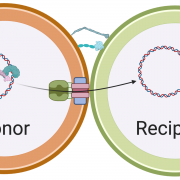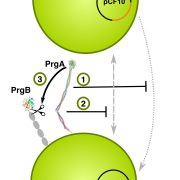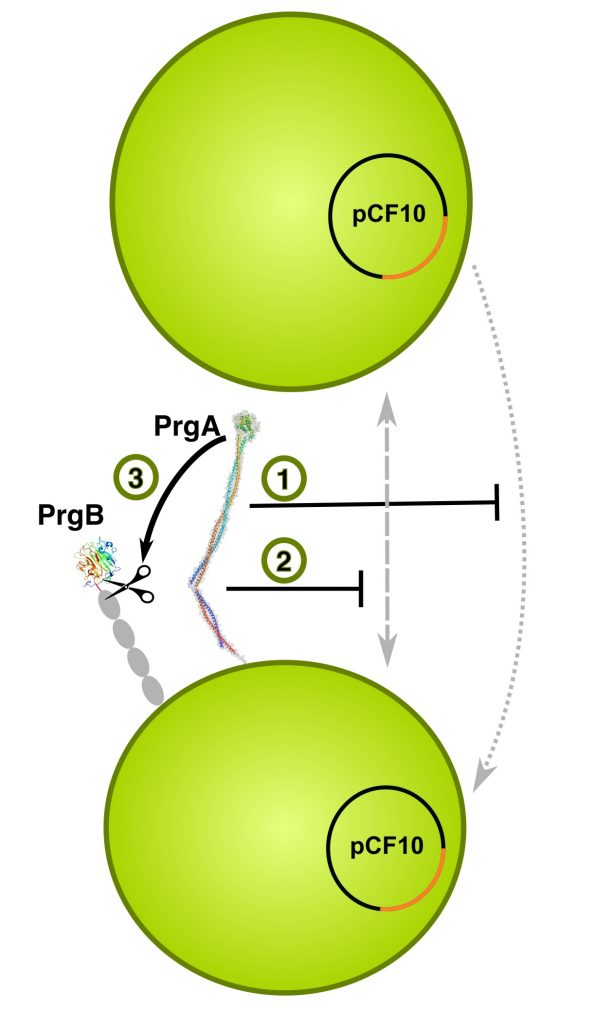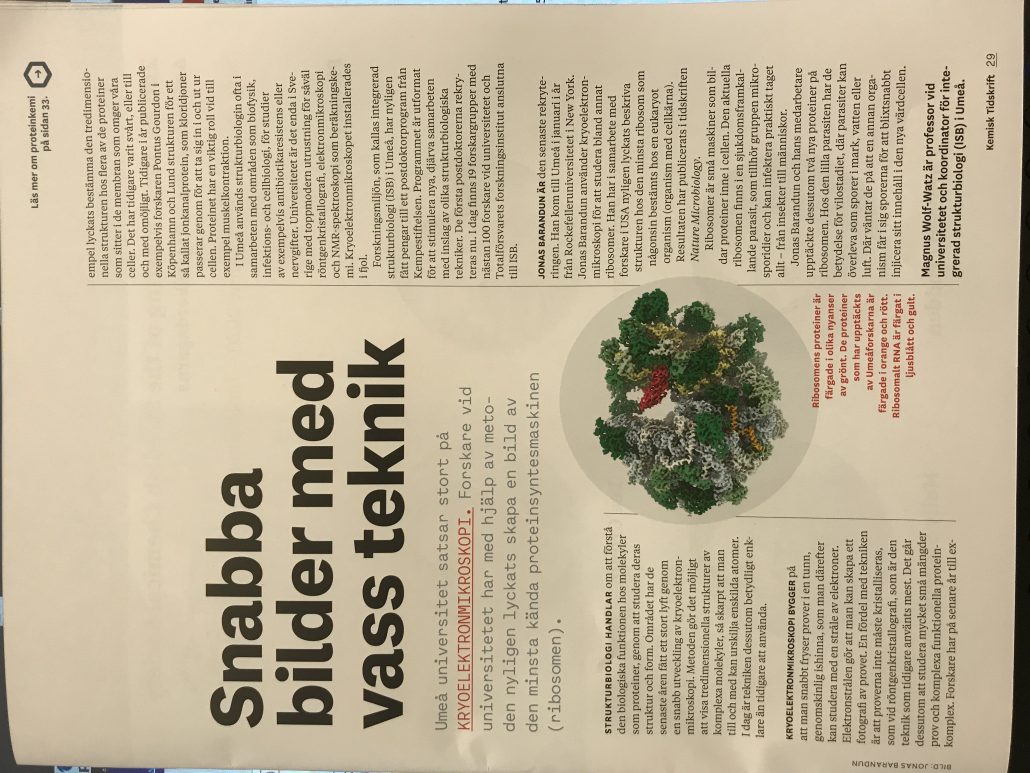Up to 3 postdoctoral fellowships are open for the 2020 call at the Integrated Structural Biology (ISB) environment at Umeå University. Umeå University offers a vibrant and international atmosphere for structural biology research. There are 19 research groups and close to 100 persons affiliated with ISB. The ISB environment has regular seminars and candidates will be broadly exposed to different structural biology techniques. The university has state of the art infrastructure for cryoEM, NMR spectroscopy, supercomputing and x-ray crystallography (please visit www.biostruct.umu.se for details on research groups and equipment).
The openings will be filled using a procedure adapted from EMBL and up to 3 top candidates that has applied to one of the 7 available projects will be selected. The projects are interdisciplinary and will ensure that the candidate will receive competitive training.
The program is open to all nationalities with relevant doctoral level education and work experiences and the openings will include the following to be considered by potential candidates:
- Two years funding (incl. running costs) for research within a multidisciplinary structural biology environment
- Access to ISB affiliated core facilities and technical platforms
- Integration with postdocs at ISB and also MIMS (Molecular Infection Medicine Sweden) for carrier development and joint activities
Instructions
Candidates should submit their:
- CV
- Publications
- Certificates and diplomas
- A Motivation Letter (max 2 A4 pages), specifying: i) why you are interested in performing postdoc research studies within ISB and ii) why in particular you wish to do this with the PI:s and project idea selected from our list.
- Reseach plan for the project (max 1 A4 page). We strongly encourage the applicants to contact the PIs for discussion of the project before submission.
Please email your application to ISB@umu.se no later than April 13. For inquires please contact the indicated lead-PI or co-PI’s from the list of projects. Further info about the ISB Postdoctoral program can be found here: https://www.biostruct.umu.se/isb-postdoctoral-program/
PROJECTS
Please find here below a list of the available projects together with contact information to PI’s.
Membrane interactions during apoptosis – a data-driven simulation approach
The grand challenge in low-resolution structural biology methodologies is the structural interpretation of the data. In recent years, data-driven computer simulation has emerged as a powerful tool with huge potential to extract detailed structural information from low- resolution data due to ever-increasing capabilities in parallel supercomputing and novel algorithms. The main aim of this postdoc project is to develop a data-driven simulation method to elucidate the mechanism behind the association of apoptotic Bax protein to mitochondrial-membrane interfaces and its subsequent partitioning; information essential for a molecular understanding of a key step in apoptosis, namely the cell-death causing membrane perforation.
The work includes building of simulation systems to mimic the mitochondrial lipid composition under apoptotic oxidative stress conditions, hydration levels, and protein content, as used in the neutron reflectometry experiments. A computationally efficient way to generate in-simulation calculated scattering profiles will be developed to bias simulations towards a molecular-level structural solution; work to be supervised by Dr. Andersson. Importantly, the postdoc will be involved in sample preparation and all stages of the neutron scattering experiments, supervised by Dr. Gröbner (and preliminary data already at hand). The project will generate new insight into a key step in mitochondrial apoptosis and it will put forward a data-driven approach that goes beyond today’s state-of- the-art to model neutron reflectometry data; which will be required at the upcoming national ESS infrastructure with its innovative reflectometry capabilities.
Lead PI: Magnus Andersson: magnus.p.andersson@umu.se
Co-PI: Gerhard Gröbner: gerhard.grobner@umu.se
Structural studies of virus-host interactions by cryo-electron tomography on virus-infected human organoids
What questions molecular biologists can answer is highly dependent on the research methods and model systems at their disposal. In this project we aim to combine cutting-edge advances in both infection models and cryo-electron tomography to study human enteric viruses. The group of Niklas Arnberg has long experience in working with both enteroviruses and with enteric adenoviruses. The Arnberg group are currently establishing human gut organoids (“enteroids”) as a more realistic model system to study infection of the gut. On the structural biology side, a major limitation for structural analysis by cryo-EM is the sample size. The standard plunge-freezing methods used in cryo-EM can only vitrify samples to a thickness of ~1 μm. Leveraging on the extensive infrastructure at UCEM, the Carlson group have developed a high-pressure freezing-based method that would allow structural studies by cryo-electron tomography of virus-infected organoids. Combining these methods, the postdoc will be able to study host-cell remodelling by enteric viruses in situ in human organoids. This will allow visualisation of complex tissue-dependent processes, e.g. depending cell type and tissue polarity, with the unprecedented structural fidelity of cryo-electron tomography.
Lead PI: Lars-Anders Carlson: lars-anders.carlson@umu.se
Co-PI: Niklas Arnberg: niklas.arnberg@umu.se
Mechanistic study of the autophagic protein ATG8/LC3 in membrane morphogenesis using NMR
Autophagy is a highly conserved and sophisticated “self-eating” process in eukaryotes and plays a key role in human health and disease. Formation of double- membrane autophagosomes is the key process in autophagy. The LC3 protein family (mammalian homologs of yeast ATG8) conjugated to phosphatidylethanolamine (PE) is required for autophagosomal membrane expansion and closure. However, the molecular mechanisms of these processes remain unclear. We have earlier prepared LC3-PE proteins by semisynthetic approaches and showed that LC3-PE promotes membrane fusion in vitro. The aim of this project is to gain molecular insights into how ATG8/LC3-PE mediates membrane morphogenesis. To this end we will use structural biology tools, primarily NMR, to study ATG8/LC3-PE together with lipids. NMR can provide a wealth of information about not only protein structure, but also details about lipid properties in membrane bilayers. In this way we can simultaneously investigate the effect that lipids have on the properties ATG8/LC3-PE and the effect that the protein has on membrane morphology. The work will involve both protein chemistry, and advanced NMR spectroscopy to study both protein structure, and lipid properties.
Lead PI: Lena Mäler: lena.maler@umu.se
Co-PI: Yaowen Wu: yaowen.wu@umu.se
Understanding assembly and function of the bacterial cell wall
Bacteria are protected from environmental insults by a peptidoglycan (PG) cell wall. Hence, the enzymes involved in the production and turnover of PG are preferred targets for many of our most successful antibiotics. However, emerging resistant bacteria are threatening the very foundations of modern infection medicine by eroding the efficacy of our antibiotic arsenal. Identifying new genetic determinants of the bacterial cell wall as antibiotic targets, and characterizing them biochemically and structurally is of highest international priority but turns out to be a very difficult task. Our team has discovered a novel Penicillin Binding Protein conserved in a number of Gram-negative pathogens (e.g. Vibrionaceae, Pseudomonadaceae, Burkholderiaceae). Preliminary data shows that it supports PG fitness under challenging environmental adaptation (e.g. low osmolarity), suggesting that it could be a new phylum-specific antimicrobial target. This research is focused on characterizing structurally and biochemically this new PBP from V. cholerae – Vc1321. It’s is a membrane protein of 1023 amino acids. The protein is likely dimeric through disulfide bridges. We have demonstrated its bifunctional transglycosylase and transpeptidase domains both in vitro and in vivo and we are now applying all sorts of genetics to understand more about its biological function and network partners.
Vc1321, renamed as PBP1V, has been cloned, expressed and purified. Characterization of the structure, kinetics, and dynamics would help to understand catalytic peculiarities and putative interaction domains with other partners. Understanding the nature and function of PBP1V might provide a new way to increase our armory of growth-affecting compounds of low or no toxicity, an unexplored ground for the development of a species-specific class of antimicrobials for clinical therapies.
Lead PI: Elisabeth Sauer-Eriksson: elisabeth.sauer-eriksson@umu.se
Co-PI: Felipe Cava: felipe.cava@umu.se
Green Structural Biology in cellulose and silk biotechnology
An important aspect of green chemistry and a sustainable and circular economy is to develop environmentally friendly methodology to retrieve valuable chemicals from complex biomaterials. This interdisciplinary project tackles this challenging task by exploring the molecular mechanisms underlying enzymatic processing of recalcitrant natural polymers: cellulose and silk fibers. In the project we focus on two enzymes that bring novel functionality in cellulose and silk bio-processing by softening their structure and paving the way for further biocatalytic transformation of the fibers.
We are seeking a structural biologist with a strong background in biochemistry and/or protein production with different expression organisms. The structural biology background may be in any of the areas of NMR spectroscopy, single particle cryo EM or x-ray crystallography. The project is based on novel discoveries in both the Jönsson and Wolf-Watz laboratories. The successful candidate will have the possibility to define and shape the project dependent on background and ambitions and may focus on both enzymes and/or the structures of cellulose and silk-based biomaterials.
Lead PI: Magnus Wolfl-Watz: magnus.wolf-watz@umu.se
Co-PI: Leif Jönsson: leif.jonsson@umu.se
Multimolecular complexes providing surface stability of caveolae and direct connection sites to the endoplasmatic reticulum for fatty acid uptake
Caveolae are small invaginations of the plasma membrane involved in regulating lipid homeostasis. Patients and mice models lacking key structural components of caveolae are severely impaired in their ability to store fat. Caveolae are stabilized at the plasma membrane via assembly of specific proteins around the caveolae neck creating a narrow membrane funnel. It is currently unclear how these proteins structurally assemble at the membrane interphase of the caveolae neck to mediate stabilization of caveolae. Furthermore, based on preliminary data, we hypothesize that the role of caveolae in fatty acid uptake is conveyed by direct connection sites between caveolae and cellular organelles. The idea of this project is to; a) structurally characterize the stabilizing protein-complexes at the caveolae neck as well as connection sites to organelles in cells using correlative light and electron microscopy (CLEM) volume imaging. b) Resolve ATP-dependent kinetics and structural rearrangements in caveolae-stabilizing proteins during membrane assembly at high temporal resolution using reconstituted model systems.
Lead PI: Linda Sandblad: linda.sandblad@umu.se
Co-PI: Richard Lundmark: richard.lundmark@umu.se
Co-PI: Magnus Andersson: magnus.p.andersson@umu.se
Structural basis of misfolded SOD1 toxicity in human motor neurons
ALS is a rapidly progressing neurodegenerative disease with no cure. Protein unfolding, misfolding and aggregation are intimately linked to the etiology of the ALS and seem to involve prion-like mechanisms of templated protein aggregation. However, the structure of misfolded protein species responsible for ALS has yet to be defined. The gene encoding the SOD1 protein was the first identified genetic cause of ALS and we have now identified a highly cytotoxic form of the misfolded SOD1 protein derived under defined conditions in vitro. The aim of this project is to resolve the structure this potentially disease-causing form of SOD1 using Cryo-EM, and also study its localization and protein interaction in cultured human patient derived motor neurons using correlated light and electron microscopy (CLEM) including tomography. This will enable the structure and activity of SOD1 protein aggregates to be understood in relation to ALS.
Lead PI: Linda Sandblad: linda.sandblad@umu.se
Co-PI: Jonathan Gilthorpe: jonathan.gilthorpe@umu.se
Co-PI: Richard Lundmark: richard.lundmark@umu.se





